
-
Find the right food for your pet
Take this quiz to see which food may be the best for your furry friend.
Find the right food for your pet
Take this quiz to see which food may be the best for your furry friend.
Featured products
 Adult Healthy Cuisine Roasted Chicken, Carrots & Spinach Stew Dog Food
Adult Healthy Cuisine Roasted Chicken, Carrots & Spinach Stew Dog FoodDelicious roasted chicken paired with tender vegetables in a succulent stew
Shop Now Small & Mini Savory Stew with Chicken & Vegetables Dog Food
Small & Mini Savory Stew with Chicken & Vegetables Dog FoodA delicious complement to the nutrition of Science Diet Small & Mini 7+ dog food
Shop Now Adult 7+ Perfect Digestion Chicken, Whole Oats & Brown Rice Recipe Dog Food
Adult 7+ Perfect Digestion Chicken, Whole Oats & Brown Rice Recipe Dog FoodScience Diet's breakthrough nutrition supports ultimate digestive well-being & healthy microbiome for dogs age 7+
Shop NowFeatured products
 Adult 7+ Tender Tuna Dinner Cat Food
Adult 7+ Tender Tuna Dinner Cat FoodWith delicious chunks in a decadent gravy
Shop Now Adult Savory Entrée Can Variety Pack Cat Food
Adult Savory Entrée Can Variety Pack Cat FoodPrecisely balanced nutrition with the delicious taste of savory minced chicken to help fuel the energy needs of cats during the prime of their life
Shop Now Adult 7+ Senior Vitality Chicken & Vegetable Stew Cat Food
Adult 7+ Senior Vitality Chicken & Vegetable Stew Cat FoodImproves Everyday Ability to Get Up & Go
Shop Now -
Dog
- Dog Tips & Articles
-
Health Category
- Weight
- Food & Environmental Sensitivities
- Urinary
- Digestive
- Joint
- Kidney
-
Life Stage
- Puppy Nutrition
- Adult Nutrition
- Senior Nutrition
Cat
- Cat Tips & Articles
-
Health Category
- Weight
- Skin & Food Sensitivities
- Urinary
- Digestive
- Kidney
-
Life Stage
- Kitten Nutrition
- Adult Nutrition
Featured articles
 Why Are Dogs and Cats So Cute?
Why Are Dogs and Cats So Cute?If waggy puppy dog tails and furry kitten yawns make you swoon, you're not alone. Why are cats so cute? And, dogs too! Let's find out!
Read More Do Dogs and Cats have Belly Buttons?
Do Dogs and Cats have Belly Buttons?Learn whether cats & dogs have belly buttons like humans, what the function is, and if there are any health concerns associated with it.
Read More Does My Pet Hate Me?
Does My Pet Hate Me?Learn tips for bonding with your pet if you've ever thought, 'My dog doesn't like me, or 'Why do I have a standoffish cat?'
Read More -


Gingivitis is the most common type of oral disease among cats. It's as prevalent among cats as it is in dogs or humans. However, cat gingivitis may involve more than the simple swelling and bleeding of the gums you might experience in your own mouth. Indeed, in some cases, it can be life-threatening.
Because it's so common — as well as potentially complex and severe — it's important for cat parents to understand the causes and signs of feline gingivitis, as well as basic treatment and prevention measures.
What Is Gingivitis?
Gingivitis is a swelling of the gums. It mostly occurs in senior cats, when plaque builds up and the gums respond with swelling, redness, bleeding and sensitivity. Plaque is an accumulation of bacteria combined with substances that turn the mix into a concretion that adheres to the teeth. Plaque leads to swelling of both the gums and the periodontal ligament — the structure that attaches teeth to the underlying bone.
When the periodontal ligament reacts to plaque with swelling and deterioration, the resulting disorder is referred to as periodontitis, or periodontal disease. When the gums react, the result is gingivitis. These diseases are often incorrectly used interchangeably, so it's important to distinguish them from one another.
Causes of Gingivitis in Cats
In most cats, gingivitis is the result of gradual plaque accumulation, a process that occurs as cats age. There's tremendous variation in the degree to which cats' gums react to plaque. Some cats seem to accumulate large amounts of plaque with a minimum of gingivitis while other cats' gums react more severely.
A cat's unique degree of gingivitis largely has to do with genetics, but gingivitis in cats can also be affected by certain conditions, including:
- Infectious diseases: Feline leukemia virus and feline immunodeficiency virus are the most common infectious diseases that can lead to gingivitis.
- Tooth resorption: The cavity-like lesions that characterize this condition can cause gingivitis around the affected teeth.
- Juvenile-onset gingivitis: Teething cats typically experience mild gingivitis, but severe gingivitis can also occur after adult teeth come in.
- Fractured teeth: Traumatic conditions can trigger gingivitis.
- Malocclusions: Misaligned teeth and other orthodontic abnormalities may lead to gingivitis.
- Eosinophilic granuloma complex: This inflammatory disease can sometimes affect the lips, gums, tongue and, consequently, nearby teeth.
- Gingival hyperplasia: While less common in cats than dogs, gum overgrowth leads to gingivitis in both animals.
- Gingivostomatitis: This disease is the result of an extreme overreaction of the gums and surrounding oral tissues to dental tissues and plaque, and can cause a debilitating amount of pain. Cats with the condition may be unable to eat or drink. Cats with stomatitis, a chronic form gingivitis with inflammation in your cat's mouth can be severe enough to require a full mouth extraction.
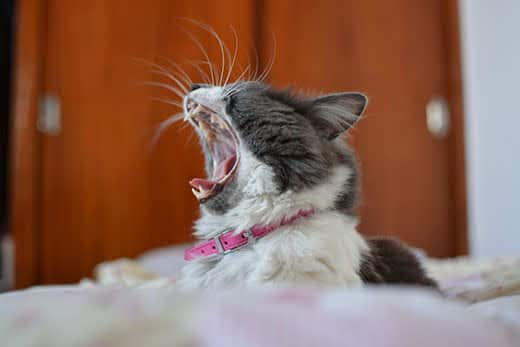
Signs of Feline Gingivitis
The primary signs of feline gingivitis include redness and bleeding at the gumline. More severely affected cats will have oral pain. You'll be able to tell whether your cat is in pain if they do any of the following:
- Drool
- Show an unwillingness to eat and/or drink
- Sit in front of the food or water bowl
- Eat messily or eat with one side of the mouth
- Cry or yowl when eating
- Lose weight
Some severely affected cats will display only very subtle signs of pain. Make frequent health checks and dental cleanings to ensure your cat's mouth and teeth get thoroughly examined on a regular basis.


Tasty Tips
Treating Feline Gingivitis
Addressing plaque is the main goal of gingivitis treatment. Routine dental cleaning under anesthesia can usually take care of plaque buildup. Annual dental cleanings are strongly recommended, with some cats requiring more frequent cleanings. Veterinary dentists, those with additional specialized education in animal dentistry that may perform more complex oral examinations or surgeries from your general veterinarian, don't recommend anesthesia-free dentistry. For more severe cases, veterinarians employ or recommend the following measures:
- Antibiotic therapy
- Anti-inflammatory medicine, such as corticosteroids and other immune-modulating drugs
- Dental extraction(s), including full-mouth extractions for cats with severe gingivostomatitis
- Gingivectomy (removal of part of the gums)
- Stem cell therapy
While once thought to be promising, laser therapy has not yet been shown to be effective.
Preventing Gingivitis in Cats
Plaque control is by far the most effective means of preventing gingivitis in most cats, with daily teeth brushing being the best method. Water additives, chlorhexidine rinses and plaque-control treats are of lower value but can be somewhat effective.
Contrary to common belief, research has yet to show that cat gingivitis can be prevented simply by feeding a cat dry food. When paired with regular dental cleanings, however, specially formulated dental cat foods have been shown to be effective at reducing plaque accumulation and reducing gingivitis. Be sure to ask your veterinarian for foods that are VOHC (Veterinary Oral Health Council) approved — foods that have been shown to reduce tartar and plaque in cats. Cats with more advanced gingivitis tend to ingest and digest moist food better than dry food.
Feeding your cat nutritionally complete and balanced meals is required to help maintain their overall oral health. Coupled with routine dental care, regular veterinary visits and daily brushing, most cats' gingivitis can be successfully managed.


Dr. Patty Khuly is an award-winning veterinarian known for her independent thinking, her spirited pet advocacy, her passion for the veterinary profession, and her famously irreverent pet health writing.
Dr. K is an honors graduate of both Wellesley College and the University of Pennsylvania School of Veterinary Medicine. She received her MBA at The Wharton School of Business as part of the prestigious VMD/MBA dual-degree program. She now owns Sunset Animal Clinic, a veterinary practice in Miami, Florida.
Related products

Precisely balanced nutrition with the delicious taste of savory minced chicken to help fuel the energy needs of cats during the prime of their life

With delicious chunks in a decadent gravy

Improves Everyday Ability to Get Up & Go

Supports energy level and beautiful fur in mature cats
Related articles
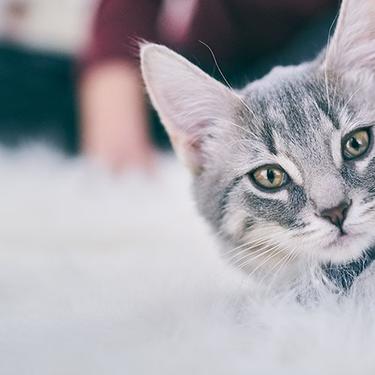
Discover the benefits of Hill's line of kitten foods and how they provide complete and balance nutrition for growing kittens.
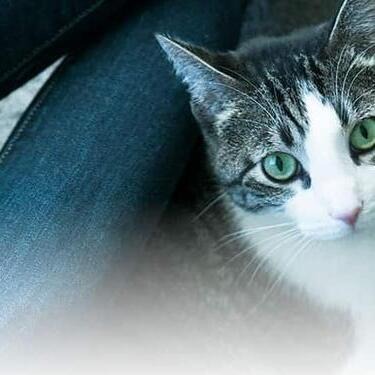
Brushing your cat's teeth is just as important as brushing your own. Learn signs or oral health problems in your cat and how to avoid them.
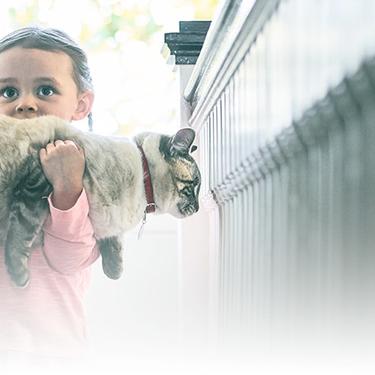
Discover how to identify cat sensitive skin and what you can do to help your cat thrive from head to paw.
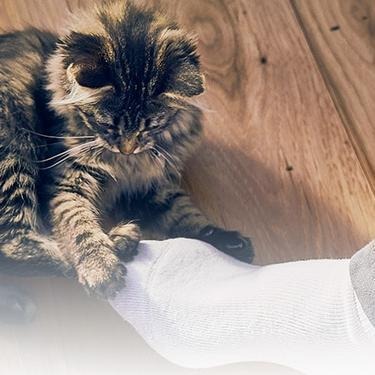
Discover which cat toys games your feline friend might like, and how they are great sources of exercise. Explore our library of articles to learn more.

Put your cat on a diet without them knowing
Our low calorie formula helps you control your cat's weight. It's packed with high-quality protein for building lean muscles, and made with purposeful ingredients for a flavorful, nutritious meal. Clinically proven antioxidants, Vitamin C+E, help promote a healthy immune system.
Put your cat on a diet without them knowing
Our low calorie formula helps you control your cat's weight. It's packed with high-quality protein for building lean muscles, and made with purposeful ingredients for a flavorful, nutritious meal. Clinically proven antioxidants, Vitamin C+E, help promote a healthy immune system.

